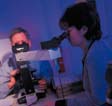 The
mouse that roared Cardiff has a keen eye for interpreting mouse histopathology specimens, able to discern whether the grainy images under a microscope show malignancies or normal tissue variations. In the process, he's diagnosed abscesses where investigators have seen tumors; infection where researchers have seen immunologic disease. "I provide a service because of my ability to see correlations between the work of other researchers," says Cardiff, whose spare office includes walls of medical degrees, a covered microscope, and a computer topped with a Mickey Mouse hat. "Researchers will send slides to their local histopathologist, someone who may not have the time to interact with the researcher. We're expected to verify a diagnosis, but I'm also interested in the science behind the slides." Emmett Schmidt, an investigator at Massachusetts General Hospital in Boston, can attest to Cardiff's acumen. In 1996 Schmidt and his colleagues created a trans- genic mouse with an overex- pression of suspected oncogene cyclin D1 in its mammary cells. Schmidt expected the mouse would have a high incidence of breast cancer, but the mice were already a year old and only one of 15 showed tumor activity. Schmidt was beginning to doubt his hypothesis. Schmidt shipped samples from his transgenic mice off to UC Davis, where Cardiff prepared and examined the slides. He was able to recognize irregularities in 12 specimens as early cancerous changes. Schmidt was on he right path after all; he just needed to wait a little longer.
Home |
Table of Contents |
To our Readers |
Building on Basics UC Davis Health System | © 2000, 2001, 2002 UC Regents. All rights reserved. |
Cardiff and Ana Nieto, a visiting veterinary pathologist from Madrid, examine stained mouse mammary cells. |

